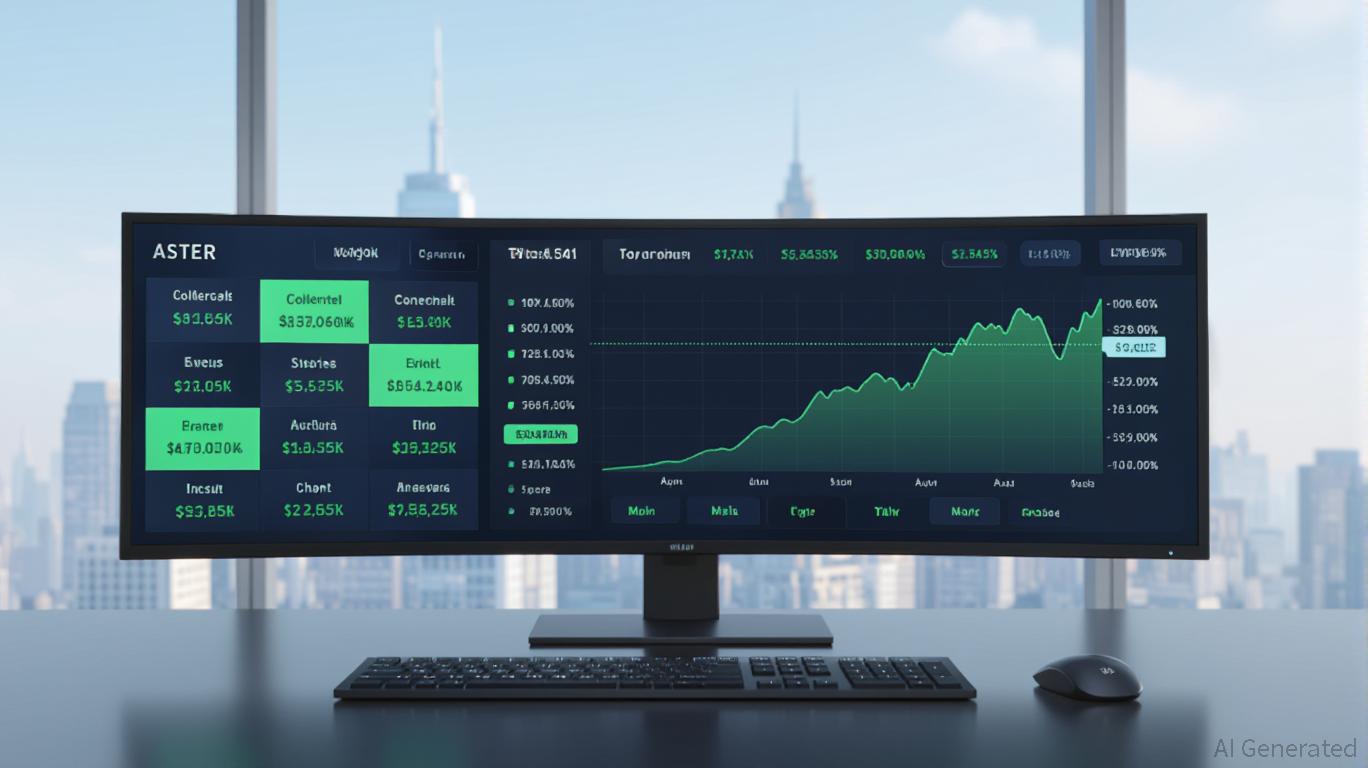Aster DEX's Latest Strategic Move and Its Influence on DeFi Liquidity
- Aster DEX's 2025 governance changes redefined ASTER as a functional trading collateral and fee discount asset, boosting liquidity provider (LP) engagement. - The 80% margin ratio and 5% fee discount incentivized LPs to reallocate capital, adjust staking behaviors, and adopt novel yield strategies like "Trade & Earn." - ASTER's price surged 860% post-TGE, TVL grew from $172M to $2.18B, and Coinbase's roadmap inclusion signaled institutional validation of the platform's privacy-focused DeFi model. - Upcomi
Governance Changes: ASTER as Collateral and Fee Discounts
Aster DEX’s announcement on November 5, 2025, represented a significant turning point. Token holders are now able to use ASTER as collateral to open leveraged trades, with the 80% margin ratio meaning $1,000 in ASTER unlocks $800 in trading leverage. This reduces dependence on external assets such as stablecoins or
The timing of this policy shift was deliberate. Just three days earlier, Binance founder Changpeng Zhao (CZ) made headlines by acquiring $2 million in ASTER, causing a 30% price jump and an 800% increase in trading activity, as reported by
Liquidity Provider Strategy Adaptations
Liquidity providers have quickly responded to these updates, making ASTER a central asset in their holdings. Collateral reallocation is now a prevailing trend: users are moving away from traditional collateral like
Staking patterns have also shifted. With ASTER serving both as a governance token and trading collateral, LPs are encouraged to hold it for the long term. They now stake ASTER not only for returns but also to access fee reductions and ensure liquidity in perpetual markets. This is a departure from earlier DeFi models, where tokens were often sold off for quick profits, as described by
Yield farming tactics have broadened with the rollout of the "Trade & Earn" feature, enabling users to use yield-generating assets like asBNB and USDF as margin for trading, as outlined by

Market Response and Institutional Recognition
The market has reacted positively to Aster DEX’s governance reforms. ASTER’s price climbed from $0.08 to $0.79 within two days of its token generation event (TGE) in September 2025, peaking at $2 before settling in the $1.3–1.5 range, as documented by
Coinbase’s decision to add ASTER to its November 2025 roadmap further underscores the platform’s promise, as mentioned by
Future Outlook: Aster Chain and DeFi Implications
Aster DEX’s long-term strategy looks beyond 2025. The team is building Aster Chain, a Layer-1 blockchain with a privacy-first approach, scheduled for launch in Q1 2026. It will employ zero-knowledge proofs to prevent front-running and bolster transaction confidentiality, as reported by
The wider DeFi sector is also changing. Rivals such as Hyperliquid and Lighter are competing with improved fee structures, but Aster DEX’s emphasis on practical governance and privacy sets it apart. As TVL and trading activity continue to grow, the platform’s ability to keep ASTER as a utility token will be vital for its ongoing expansion.
Conclusion
The 2025 governance reforms at Aster DEX have sparked a significant transformation in DeFi liquidity management. By making ASTER a versatile asset, the platform has motivated LPs to shift collateral, alter staking habits, and embrace new yield farming methods. With mounting institutional support, rapid TVL growth, and forthcoming privacy upgrades, Aster DEX is poised to reshape the decentralized trading landscape.
Disclaimer: The content of this article solely reflects the author's opinion and does not represent the platform in any capacity. This article is not intended to serve as a reference for making investment decisions.
You may also like
Ethereum Updates: Shodai Network Secures $2.5M in Seed Funding to Address Crypto’s Capital Challenges
- Shodai Network raised $2.5M in seed funding led by ConsenSys to address crypto's "toxic capital" misalignment issues. - The platform aims to align incentives between developers and investors through open-source tools and community-driven structures. - Backed by Ethereum co-founder Joseph Lubin, Shodai faces regulatory risks but gains credibility through ConsenSys' technical expertise. - This initiative reflects growing institutional demand for sustainable crypto fundraising solutions amid intensified reg

Ark Invest Turns to Circle Amid Growing Regulatory Certainty in Stablecoin Industry
- Ark Invest boosts Circle stake by 353,300 shares, signaling confidence in stablecoin growth amid market volatility and regulatory clarity. - Circle reports $740M Q3 revenue (66% YoY) and $73.7B USDC circulation, but faces margin pressures and a $482M net loss despite strong cash flow. - Ark shifts focus from Tesla to Circle and Alibaba , selling $30. 3M in Tesla shares amid China sales concerns and AI-driven tech bets. - Regulatory progress like the U.S. GENIUS Act and Circle's strategic partnerships (e.
EigenZero’s Reward-Based Approach to Overcoming Cross-Chain Trust Issues
- EigenCloud and LayerZero launch EigenZero, a decentralized cross-chain validation network using economic incentives and cryptographic constraints. - The "optimistic verification" model slashes staked ZRO tokens for malicious activity, aligning validator interests with network security. - By combining LayerZero's interoperability with EigenCloud's staking infrastructure, EigenZero reduces reliance on centralized bridges while maintaining trustless validation. - The solution enables scalable, cost-effectiv
Japan Strengthens Cryptocurrency Regulations and Tests Stablecoins to Foster Innovation While Ensuring Investor Confidence
- Japan's FSA and JPX are strengthening crypto regulations to prevent risks from hoarding and insecure management, balancing innovation with investor protection. - The FSA's proposed pre-approval system for crypto providers aims to address vulnerabilities exposed by the $312M DMM Bitcoin hack linked to Tokyo firm Ginco. - JPX plans to restrict listed companies from accumulating digital assets, following global trends as Japan hosts 14 listed Bitcoin buyers—the most in Asia. - Parallel stablecoin pilots wit